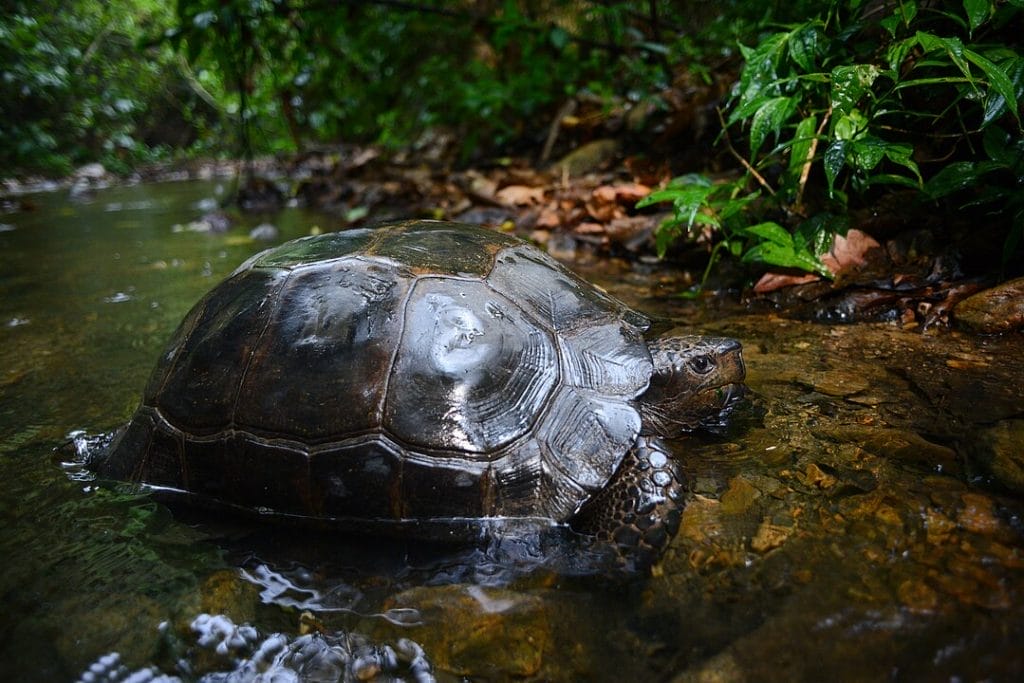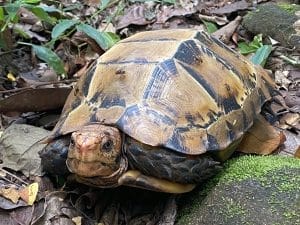Manouria emys (Asian forest tortoise)
Home > Turtle Database > Manouria emys (Asian forest tortoise)

Manouria emys, commonly known as the Asian forest tortoise, is the largest tortoise native to mainland Asia. Known for its adaptability, it inhabits dense forests and is highly active compared to other tortoise species.
Native To These Regions
Assam (India), Bangladesh, Borneo (Malaysia/Indonesia), Cambodia, Hainan (China), India, Indonesia, Laos, Malaysia, Myanmar, Sumatra (Indonesia), Thailand, VietnamNative Turtle Species Map – Find Turtles by Region
Scientific Classification
Kingdom: Animalia
Phylum: Chordata
Class: Reptilia
Order: Testudines
Family: Testudinidae
Genus: Manouria
Species: Manouria emys
Common Names
Asian forest tortoise
Burmese brown tortoise
Six-legged tortoise
This Hilarious Turtle Book Might Know Your Pet Better Than You Do
Let’s be real—most turtle care guides feel like reading a textbook written by a sleep-deprived zookeeper.
This one’s not that.
Told from the snarky point of view of a grumpy, judgmental turtle, 21 Turtle Truths You’ll Never Read in a Care Guide is packed with sarcasm, sass, and surprisingly useful insights.
And hey—you don’t have to commit to the whole thing just yet.
Grab 2 free truths from the ebook and get a taste of what your turtle really thinks about your setup, your food choices, and that weird plastic palm tree.
It’s funny, it’s honest, and if you’ve ever owned a turtle who glares at you like you’re the problem—you’ll feel seen.
Identification
Description
This tortoise is characterized by a dark, dome-shaped carapace with serrated edges at the rear. Its plastron is lighter in color and less domed. Adults can grow up to 60 cm in length and weigh around 30 kg. Their scaly limbs are strong, aiding them in navigating rugged forest terrain.
Sexual Dimorphism
Males have a slightly concave plastron and longer tails, while females have flatter plastrons and shorter tails.
Check more turtles from the Manouria genus
Native Origin and Distribution
Geographical Range
Manouria emys is native to Southeast Asia, found in countries such as Myanmar, Thailand, Malaysia, Indonesia, and parts of India.
Preferred Habitat
This species prefers tropical and subtropical forests with high humidity. It is often found in regions with dense undergrowth, near streams or moist areas, as it thrives in a cool and wet environment.
Behavior
Feeding Habits
Asian forest tortoises are herbivorous, feeding on a diet of leaves, fruits, fungi, and grasses.
Predators
Natural predators include large mammals, birds of prey, and humans. Hatchlings are particularly vulnerable to predation.
Reproduction
Breeding Season
Breeding occurs during the rainy season, typically between June and October.
Reproductive Method
Females lay clutches of 20–50 eggs, often building a nest mound from leaf litter and soil to protect the eggs. The incubation period lasts around 60–80 days.
Conservation
Extinction Status
Listed as Critically Endangered on the IUCN Red List.
Threats
Deforestation, habitat loss, and hunting for food and the pet trade are significant threats to the species.
Conservation Measures
Efforts include habitat protection, anti-poaching measures, and breeding programs in captivity to support population recovery.
Economic Importance
Manouria emys is sometimes hunted for food and its shells, although conservation measures are working to curb this practice. It is also a species of interest for ecotourism and wildlife enthusiasts.
Interesting Facts
The Asian forest tortoise is one of the few tortoise species known to build and guard its nest. Females often remain near the nest to protect it from predators. They are also excellent climbers, unusual for tortoises of their size.

About Author
Muntaseer Rahman started keeping pet turtles back in 2013. He also owns the largest Turtle & Tortoise Facebook community in Bangladesh. These days he is mostly active on Facebook.












